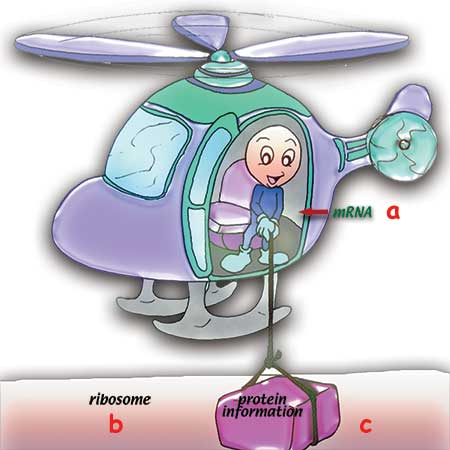After the information in the DNA needed for protein production in the cell is located and copied, it must reach the factory—in other words, the ribosomes—where production is to be carried out. These organelles, present in every cell, lie quite a distance from the DNA in the nucleus and are distributed throughout the cell’s cytoplasm, the cell’s internal fluid.
Production orders must be forwarded to these factories in perfect form and at high speed. The messenger RNA (mRNA) finds the ribosome from among all the many organelles inside the cell without losing its way. When the mRNA locates the ribosome, it settles onto its exterior in the form of a line.
The information belonging to the amino acid sequence of the desired protein has thus reaches the production center. Now, messages begin being sent to the other regions of the cell for the raw materials—amino acids, in other words—necessary for the protein to be produced and brought in (Figure 107).23
 |
| a. mRNA |
| Figure 107: After the information needed for protein production has been copied from the DNA, it is brought to the ribosome by messenger RNA and released. The messenger RNA finds the ribosome without losing its way. |
The task of searching for and finding the amino acids to be used and of bearing them to the ribosome belongs to transporter RNA (tRNA). There are 20 varieties of amino acid in every living cell. Each one of these amino acids, or raw materials, is carried by a transporter unique to itself. 24 The way amino acids bond to the tRNA that will transport them takes place as the result of a series of complex processes.
Every tRNA serving as transport carries every amino acid to the place in the ribosome set out in the production instruction, ensuring that there is no impairment of the production function.
The flawless discipline seen in these unconscious molecules, the way they behave as if possessed of awareness and responsibility, is proof that each has submitted to God, the Lord of sublime might and reason, and behaves under His control.
The information and requisite raw materials for the protein to be produced are now ready. Yet first, there is another problem to be overcome. As we have already seen, the production data—the order, in other words—is written in a special language in the DNA. Production must take place according to the data written in that language. However, the strings of amino acids to be used as raw materials are “written” in another language.
The problem may be better described thus; the written instruction in the order form is in the language of the code comprising the DNA—that special “language” consisting of four letters. The proteins to be produced are communicated in a different language, with a 20-letter alphabet (because there are 20 varieties of amino acid comprising proteins). Thus, the production information coming from the DNA is not in any language the amino acids can decipher. As a result, in order for the amino acids to understand which information from the DNA is referring to, they must translate the DNA language.
In order for life to continue, the ribosome factory has been equipped with a mechanism that resolves this problem in a most perfect manner. A system has been created that translates between the two different languages used during production in the ribosome. This translation system, known as the codon-anticodon method, works in a manner far superior to even the most advanced computer centers. Just like an interpreter expert in two different languages, it turns the protein information written in the DNA language (consisting of four letters) into the protein language (consisting of 20), stating which amino acids are to be laid out alongside one another. As a result, the desired protein is accurately produced.
Worthy of particular note is the absence of any error in this translation process. There is only room for one or two errors in the production of the thousands of proteins necessary for the survival of the cell, and thus of the living things. No man-made technological apparatus nor the most careful and expert human beings could translate and write a text such as a protein—the equivalent to 200 novels—in such a flawless, perfect manner.25 However, these molecules, which behave under the control of God at all times, do everything to the letter. To rational believers, all these are manifestations of God’s miracles.
23-"Cells’ Energy Use High for Protein Synthesis" in Chemical & Engineering News, August 20, 1979, p. 6.
24- Albert Lehninger L., Late University Professor of Medical Sciences, Johns Hopkins University; David L. Nelson, Professor of Biocemistry University of Wisconsin, Madison; Michael M. Cox, Professor of Bochemistry, University of Wisconsin, Madison: Principles of Biochemistry, Second Edition, New York: Worth Publishers,[Date?] , p. 905.
25- Mahlon B.Hoagland, Hayatin Kokleri (“Origins of Life”), Tubitak Populer Bilim Kitaplari 12th ed., May 1998, p. 31.